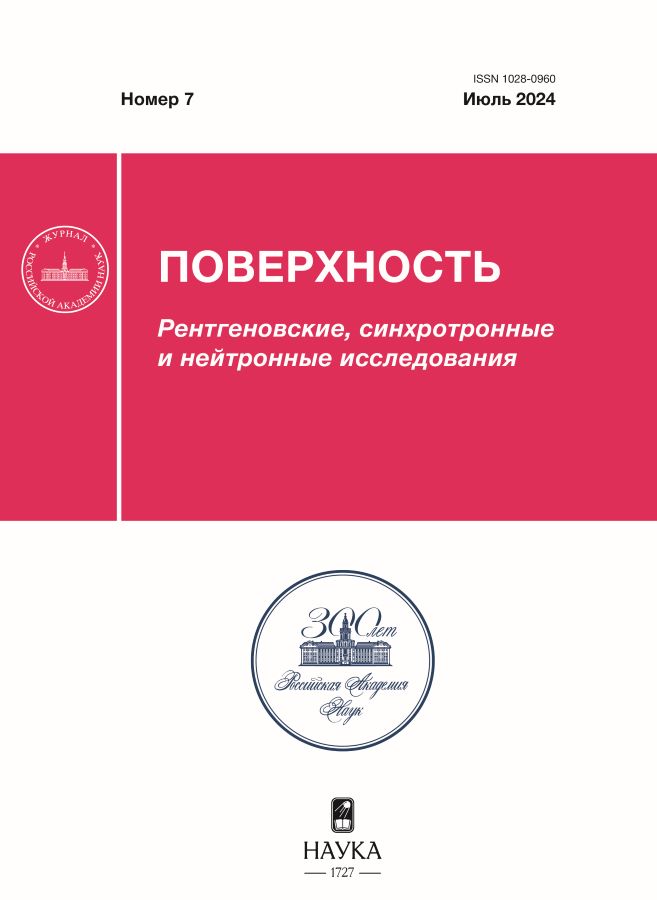Coefficients of light-ion reflection from a solid surface
- Autores: Afanas’ev V.P.1, Lobanova L.G.1, Shulga V.I.2
-
Afiliações:
- National Research University “MPEI”
- Lomonosov Moscow State University, Skobeltsyn Institute of Nuclear Physics
- Edição: Nº 7 (2024)
- Páginas: 97-102
- Seção: Articles
- URL: https://archivog.com/1028-0960/article/view/664799
- DOI: https://doi.org/10.31857/S1028096024070133
- EDN: https://elibrary.ru/EUOGQT
- ID: 664799
Citar
Texto integral
Resumo
An analytical theory of the reflection of light ions from solids is presented. The theory is based on the method of solving the elastic scattering problem (the Oswald–Kasper–Gauckler method), successfully tested in the theory of electron scattering. The solution of a boundary value problem for light ion reflection from solids based on the invariant imbedding method is constructed. Particle interaction with amorphous and polycrystalline samples is considered. Analytical formulas for calculating the integral reflection coefficients of particles and energy are obtained. It is shown that an analytical solution can be obtained only within the framework of a small-angle approximation. Obtained analytical solutions are based on the path length distribution function taking into account the maximum residual range. It was shown that within the framework of an analytical theory the reflection coefficients are determined by two dimensionless parameters — the ratio of the residual range to the transport path length and the screening parameter. The results of theoretical consideration are compared with the data of computer simulation. Numerical calculations are performed for the case of reflection of protons with initial energy E0 = 1–10 keV from Be, C, Cu and W targets for different scattering geometries. The results of the calculated integral reflection coefficients of particles and energy show the satisfactory agreement between analytics and computer simulation.
Texto integral
Sobre autores
V. Afanas’ev
National Research University “MPEI”
Autor responsável pela correspondência
Email: v.af@mail.ru
Rússia, Moscow
L. Lobanova
National Research University “MPEI”
Email: lida.lobanova.2017@mail.ru
Rússia, Moscow
V. Shulga
Lomonosov Moscow State University, Skobeltsyn Institute of Nuclear Physics
Email: vish008@yandex.ru
Rússia, Moscow
Bibliografia
- Машкова Е.С., Молчанов В.А. Применение рассеяния ионов для анализа твердых тел. М.: Энергоатомиздат, 1995. 174 с.
- Булгадарян Д.Г., Синельников Д.Н., Ефимов Н.Е., Курнаев В.А. // Известия РАН. Серия физическая. 2020. Т. 84. № 6. С. 903. https://www.doi.org/10.31857/S036767652006006X
- Bulgadaryan D., Kolodko D., Kurnaev V., Sinelnikov D. // J. Phys.: Conf. Ser. 2016. V. 748. № 1. P. 012016. https://www.doi.org/10.1088/1742-6596/748/1/012016
- Курнаев В.А., Машкова Е.С., Молчанов В.А. Отражение легких ионов от поверхности твердого тела. М.: Энергоатомиздат, 1985. 192 с.
- Mashkova E.S., Molchanov V.A. Medium energy ion reflection from solids. Amsterdam: North-Holland, 1985. 444 p.
- Калашников Н.П., Ремизович В.С., Рязанов М.И. Столкновения быстрых заряженных частиц в твердых телах. М.: Атомиздат, 1980. 272 с.
- Рязанов М.И., Тилинин И.С. Исследование поверхности по обратному рассеянию частиц. М.: Энергоатомиздат, 1985. 150 c.
- Экштайн В. Компьютерное моделирование взаимодействия частиц с поверхностью твердого тела. М.: Мир, 1995. 319 c.
- Markin S.N., Primetzhofer D., Spitz M., Bauer P. // Phys. Rev. B. 2009. V. 80. № 20. P. 205105. https://www.doi.org/10.1103/PhysRevB.80.205105
- Salvat-Pujol F., Werner W.S.M. // Phys. Rev. B. 2011. V. 83. № 19. P. 195416. https://www.doi.org/10.1103/PhysRevB.83.195416
- Afanas’ev V.P., Efremenko D.S., Kaplya P.S. // J. Electron. Spectrosc. Relat. Phenom. 2016. V. 210. P. 16. https://www.doi.org/10.1016/j.elspec.2016.04.006
- Афанасьев В.П., Лобанова Л.Г., Шульга В.И. // Поверхность. Рентген., синхротр. и нейтрон. исслед. 2023. № 1. С. 86. https://www.doi.org/10.31857/S102809602301003X
- Янке Е., Эмде Ф., Леш Ф. Специальные функции. М.: Наука, 1968. 344 с.
- Shulga V.I. // Radiat. Eff. 1984. V. 82. P. 169. https://www.doi.org/10.1080/00337578408215770
- Shulga V.I., Eckstein W. // Nucl. Instrum. Methods Phys. Res. B. 1998. V. 145. № 4. P. 492. https://doi.org/10.1016/S0168-583X(98)00626-0
- Ziegler J.F. // Nucl. Instrum. Methods Phys. Res. B. 1998. V. 136–138. P. 141. https://www.doi.org/10.1016/S0168-583X(97)00664-2 http://www.srim.org
- Koborov N. N., Kurnaev V. A., Telkovsky V. G., Zhabrev G. I. // Radiat Eff. Defects Solids. 1983. V. 69. № 1–2. P. 135. https://www.doi.org/10.1080/00337578308221731
- Tabata T., Ito R., Itikawa Y., Itoh N., Morita K. // Atomic Data Nucl. Data Tables. 1983. V. 28. № 3. P. 493. https://www.doi.org/10.1016/0092-640X(83)90004-9
- Фирсов О.Б. // ЖЭТФ. 1958. Т. 34. С. 447.
- Berger M.J., Coursey J.S., Zucker M.A., Chang J. // NIST Standard Reference Database 124. Last Update to Data Content: July 2017. NISTIR 4999. https://www.doi.org/10.18434/T4NC7P
Arquivos suplementares













